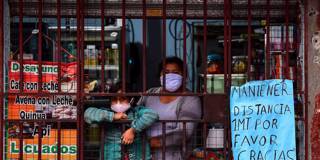The COVID-19 pandemic brought a halt to the expansion of Latin America’s middle class and pushed millions back into poverty. Reversing this pattern requires addressing the region’s vulnerability to economic shocks and strengthening countries’ resilience.
WASHINGTON, DC – Global poverty rose last year for the first time since 1998 as the economic fallout of the COVID-19 pandemic pushed an additional 97 million people below the international threshold of $1.90 per day. At first glance, Latin America and the Caribbean (LAC) appears to have fared relatively well: three million newly poor people as a result of the pandemic, compared to 58 million in South Asia. But poverty in LAC demands more attention than the headline statistic suggests.
The pandemic affected economic growth in LAC more significantly than in any other developing region last year, with GDP contracting by 6.5%. Although the region is expected to rebound strongly with 5.2% growth this year, the effect on the poor could be delayed, owing not only to relative vaccine shortages but also to traditionally slower declines in poverty relative to increases in per capita income. Moreover, those without access to the digital economy could experience additional erosion in future earnings from a looming learning and productivity crisis caused by some of the world’s longest lockdowns and school closures.
Even before the pandemic, most LAC countries were experiencing anemic growth and a slow transition from middle- to high-income status. COVID-19 likely will extend this “middle-income trap.” In its recently released annual country classifications by income level, the World Bank identified seven economies globally that dropped to a lower income category. Two, Panama and Belize, are in LAC. And countries in the region that remained in the same income category as last year saw greater divergence, rather than convergence, with wealthier economies. Specifically, the average upper-middle-income country in LAC moved 10.4% further away from achieving high-income country status in 2020 than in 2019, compared to the average global divergence of 3.8%.

WASHINGTON, DC – Global poverty rose last year for the first time since 1998 as the economic fallout of the COVID-19 pandemic pushed an additional 97 million people below the international threshold of $1.90 per day. At first glance, Latin America and the Caribbean (LAC) appears to have fared relatively well: three million newly poor people as a result of the pandemic, compared to 58 million in South Asia. But poverty in LAC demands more attention than the headline statistic suggests.
The pandemic affected economic growth in LAC more significantly than in any other developing region last year, with GDP contracting by 6.5%. Although the region is expected to rebound strongly with 5.2% growth this year, the effect on the poor could be delayed, owing not only to relative vaccine shortages but also to traditionally slower declines in poverty relative to increases in per capita income. Moreover, those without access to the digital economy could experience additional erosion in future earnings from a looming learning and productivity crisis caused by some of the world’s longest lockdowns and school closures.
Even before the pandemic, most LAC countries were experiencing anemic growth and a slow transition from middle- to high-income status. COVID-19 likely will extend this “middle-income trap.” In its recently released annual country classifications by income level, the World Bank identified seven economies globally that dropped to a lower income category. Two, Panama and Belize, are in LAC. And countries in the region that remained in the same income category as last year saw greater divergence, rather than convergence, with wealthier economies. Specifically, the average upper-middle-income country in LAC moved 10.4% further away from achieving high-income country status in 2020 than in 2019, compared to the average global divergence of 3.8%.